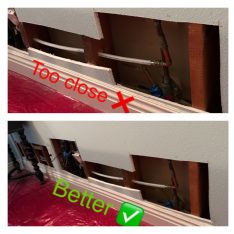Why Priming and Painting Newly Patched Drywall is Essential
When it comes to home renovations and repairs, one of the most common tasks is fixing damaged drywall. Whether it’s a small patch from a nail hole or a larger section that needs replacing, getting the wall back to its original condition is a must for a seamless look. However, the job doesn't end after the patching compound dries. Proper priming and painting are essential steps that can make or break the final result. Here’s why priming and painting newly patched drywall is crucial and how to do it effectively.
1. Ensuring a Seamless Finish
One of the most important reasons for priming and painting patched drywall is to create a seamless transition between the patched area and the surrounding wall. Drywall compound, used for patching, often has a different texture and absorbency compared to the original wall surface. If you skip the primer, the paint can look blotchy or uneven, highlighting the patched area instead of blending it in.
Primer acts as a bridge, creating a uniform surface that ensures the paint adheres evenly across the entire wall. Without it, the paint can soak into the compound at a different rate than the surrounding drywall, making it nearly impossible to achieve that smooth, consistent look.
2. Maximizing Paint Adhesion
Primer is specifically designed to enhance paint adhesion. When you apply paint directly onto patched drywall, it may not adhere well because the compound can be more porous than the original drywall surface. This can lead to peeling or chipping over time, especially in high-traffic areas or rooms with varying humidity levels, like bathrooms or kitchens.
Using a quality primer helps the paint adhere properly, reducing the risk of future paint failure. A well-primed surface gives the paint something to grip onto, ensuring it stays in place for a longer period and maintains its color and vibrancy.
3. Enhancing Durability and Protection
Applying primer before painting is not just about aesthetics; it’s also about protecting your walls. Primers create a protective layer that shields the wall and patched areas from moisture and wear and tear. This is particularly important if the patched drywall is in a high-traffic area or prone to exposure to moisture.
Without primer, paint may not form a strong bond with the drywall compound, which could make it more susceptible to damage. A primer creates a barrier that helps maintain the integrity of the wall, reducing the likelihood of water damage, peeling, and other issues.
4. Preventing Stains and Discoloration
Drywall patching compounds can sometimes contain materials that may affect the color of paint when applied over them. These materials can bleed through paint, leading to unsightly stains and discoloration. Priming the surface helps seal these compounds and prevents such issues from occurring.
Additionally, some patched areas may have a slightly different texture or sheen than the surrounding wall, which can result in uneven coloring or shine after painting. A primer helps even out these differences, ensuring that the final coat of paint looks consistent and professional.
5. Saving Time and Money in the Long Run
It might seem counterintuitive to spend extra time and money on primer and paint when you could just paint directly over the patch. However, skipping this step can result in a finish that doesn’t last as long, leading to the need for touch-ups or even repainting sooner than expected. This can end up costing more in the long run and taking more time to maintain.
Priming before painting helps you avoid repeated paint jobs. It’s a cost-effective way to ensure your repair work is durable and stays looking good for years to come.
See our how to properly Prime a patch blog here: https://perfectpatchoc.com/1584-2/
Priming and painting newly patched drywall might seem like an extra step, but it’s one that is absolutely necessary for a long-lasting, high-quality finish. By taking the time to properly prime and paint, you ensure that your repair blends seamlessly with the surrounding wall, stays durable, and looks great for years to come. So next time you tackle a drywall repair, don’t skip this crucial step – your walls will thank you.
